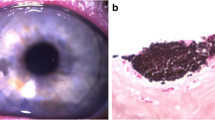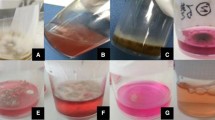Abstract
Purpose
This study aims to determine the incidence of fungal-culture-positive corneoscleral donor rim in patients undergoing keratoplasty and evaluate clinical outcomes of eyes that received these contaminated donor tissues.
Methods
Patients who had optical keratoplasty between 2006 and 2016 and were found to have fungal-culture-positive donor rim were included. Microbiological and eye bank records were reviewed to determine the incidence of positive fungal rim cultures. Data were collected on visual and clinical outcomes. The main outcome measures were fungal-culture-positive donor rim and development of fungal keratitis or endophthalmitis post keratoplasty. Long-term clinical outcome and associated complications were the secondary outcome measures.
Results
Out of 9620 cases of corneal transplants, 145 (1.5%) had fungal-culture-positive donor rim. Candida was the most common organism, cultured in 127 (87.6%) cases. There were no cases of postoperative fungal keratitis or endophthalmitis. Median follow-up was 4.8 years (interquartile range 3.8–7.2 years). Only eight cases (5.5%) received prophylactic antifungal treatment. There were 34 (23.4%) cases of rejection, 13 (8.9%) developed glaucoma, and 7 (4.8%) developed late bacterial keratitis. At last follow-up, best corrected visual acuity was 20/60 or better in 88 cases (60.7%) and 115 eyes (79.3%) had a clear graft.
Conclusion
The incidence of fungal-culture-positive donor rim is extremely low. The risk of developing fungal keratitis or endophthalmitis in patients who received contaminated donor tissue was almost negligible. Further studies are warranted to prove whether prophylaxis or adding amphotericin B in Optisol-GS confers any added benefit.
Similar content being viewed by others
References
Eifrig CW, Flynn HW, Scott IU, Newton J (2002) Acute-onset postoperative endophthalmitis: review of incidence and visual outcomes (1995–2001). Ophthal Surg Lasers Imaging Retina 33(5):373–378. https://doi.org/10.3928/1542-8877-20020901-06
Hassan SS, Wilhelmus KR (2005) Medical Review Subcommittee for the Eye Bank Association of America. Eye-banking risk factors for fungal endophthalmitis compared with bacterial endophthalmitis after corneal transplantation. Am J Ophthalmol 139:685–690. https://doi.org/10.1016/j.ajo.2004.12.016
Aldave AJ, DeMatteo J, Glasser DB, Tu EY, Iliakis B, Nordlund ML, Misko J, Verdier DD, Yu F (2013) Report of the Eye Bank Association of America medical advisory board subcommittee on fungal infection after corneal transplantation. Cornea 32(2):149–154. https://doi.org/10.1097/ico.0b013e31825e83bf
Keyhani K, Seedor JA, Shah MK, Terraciano AJ, Ritterband DC (2005) The incidence of fungal keratitis and endophthalmitis following penetrating keratoplasty. Cornea 24(3):288–291. https://doi.org/10.1097/01.ico.0000138832.3486.70
Kiatos E, Armstrong JJ, Hutnik CM, Tsioros SM, Malvankar-Mehta MS, Hodge WG (2017) The value of corneoscleral rim cultures in keratoplasty: a systematic review and cost-effectiveness analysis. ClinicoEconomics Outcomes Res: CEOR 9:459. https://doi.org/10.2147/CEOR.S139949
Vislisel JM, Goins KM, Wagoner MD, Schmidt GA, Aldrich BT, Skeie JM, Reed CR, Zimmerman MB, Greiner MA (2017) Incidence and outcomes of positive donor corneoscleral rim fungal cultures after keratoplasty. Ophthalmology 124(1):36–42. https://doi.org/10.1016/j.ophtha.2016.09.017
Tsui E, Luong PM, Fogel J, Fogel ES, Zegans ME (2019) Microbial Analysis of Donor Corneoscleral Rims and Storage Media. Ocul Immunol Inflamm 27(5):817–820. https://doi.org/10.1080/09273948.2018.1459734
Wilhelmus KR, Hassan SS (2007) The prognostic role of donor corneoscleral rim cultures in corneal transplantation. Ophthalmology 114(3):440–445. https://doi.org/10.1016/j.ophtha.2006.09.006
Cameron JA, Antonios SR, Cotter JB, Habash NR (1991) Endophthalmitis from contaminated donor corneas following penetrating keratoplasty. Arch Ophthalmol 109(1):54–59. https://doi.org/10.1001/archopht.1991.01080010056032
Al-Assiri A, Al-Jastaneiah S, Al-Khalaf A, Al-Fraikh H, Wagoner MD (2006) Late-onset donor-to-host transmission of Candida glabrata following corneal transplantation. Cornea 25(1):123–125. https://doi.org/10.1097/01.ico.0000164777.80879.07
Chu YI, Penland RL, Wilhelmus KR (2000) Colorimetric indicators of microbial contamination in corneal preservation medium. Cornea 19(4):517–520. https://doi.org/10.1097/00003226-200007000-00023
Fontana L, Errani PG, Zerbinati A, Musacchi Y, Di Pede B, Tassinari G (2007) Frequency of positive donor rim cultures after penetrating keratoplasty using hypothermic and organ-cultured donor corneas. Cornea 26(5):552–556. https://doi.org/10.1097/ico.0b013e3180415d7e
Ritterband DC, Shah MK, Meskin SW, Seedor JA, Koplin RS, Perez W, Yang R, Hu DN, Dahl P (2007) Efficacy and safety of voriconazole as an additive in Optisol GS: a preservation medium for corneal donor tissue. Cornea 26(3):343–347. https://doi.org/10.1097/ico.0b013e31802d82e8
Layer N, Cevallos V, Maxwell AJ, Hoover C, Keenan JD, Jeng BH (2014) Efficacy and safety of antifungal additives in Optisol-GS corneal storage medium. JAMA Ophthalmol 132(7):832–837. https://doi.org/10.1001/jamaophthalmol.2014.397
Sutphin JE, Pfaller MA, Hollis RJ, Wagoner MD (2002) Donor-to-host transmission of Candida albicans after corneal transplantation. Am J Ophthalmol 134(1):120–121. https://doi.org/10.1016/s0002-9394(02)01427-7
Duncan K, Parker J, Hoover C, Jeng BH (2016) The effect of light exposure on the efficacy and safety of amphotericin B in corneal storage media. JAMA Ophthalmol 134(4):432–436. https://doi.org/10.1001/jamaophthalmol.2016.0008
Edelstein SL, DeMatteo J, Stoeger CG, Macsai MS, Wang CH (2016) Report of the Eye Bank Association of America medical review subcommittee on adverse reactions reported from 2007 to 2014. Cornea 35(7):917–926. https://doi.org/10.1097/ico.0000000000000869
Jensen RH, Astvad KMT, Silva LV, Sanglard D, Jørgensen R, Nielsen KF, Mathiasen EG, Doroudian G, Perlin DS, Arendrup MC (2015) Stepwise emergence of azole, echinocandin and amphotericin B multidrug resistance in vivo in Candida albicans orchestrated by multiple genetic alterations. J Antimicrob Chemother 70(9):2551–2555. https://doi.org/10.1093/jac/dkv140
Maguire MG, Stark WJ, Gottsch JD, Stulting RD, Sugar A, Fink NE, Schwartz A, Collaborative Corneal Transplantation Studies Research Group (1994) Risk factors for corneal graft failure and rejection in the collaborative corneal transplantation studies. Ophthalmology 101(9):1536–1547. https://doi.org/10.1016/s0161-6420(94)31138-9
Wagoner MD, Gonnah ES, Al-Towerki AE King Khaled Eye Specialist Hospital Cornea Transplant Study Group (2009) Outcome of primary adult penetrating keratoplasty in a Saudi Arabian population. Cornea 28(8):882–890. https://doi.org/10.1097/ico.0b013e31819b00d8
Brennan TV, Lunsford KE, Kuo PC (2010) Innate pathways of immune activation in transplantation. J Transpl. https://doi.org/10.1155/2010/826240
Acknowledgements
None.
Funding
This study was not funded by an internal, external, or international agency, institute, or organization.
Author information
Authors and Affiliations
Corresponding author
Ethics declarations
Conflict of interest
All authors declare that they have no conflicts of interest.
Ethical approval
This article does not contain any studies with human participants or animals performed by any of the authors.
Informed consent
Informed consent was not obtained from individual participants included in the study. This retrospective chart review study involving human participants was in accordance with the ethical standards of the institutional and national research committee and with the 1964 Helsinki Declaration and its later amendments or comparable ethical standards. The Human Investigation Committee (IRB) of the hospital approved this study.
Additional information
Publisher’s Note
Springer Nature remains neutral with regard to jurisdictional claims in published maps and institutional affiliations.
Rights and permissions
About this article
Cite this article
Alshabeeb, R.S., Aldayel, A.A., Martinez-Osorio, H. et al. Incidence and outcome of transplantation of fungal-culture-positive donor corneoscleral tissue in optical keratoplasty. Int Ophthalmol 41, 867–873 (2021). https://doi.org/10.1007/s10792-020-01641-9
Received:
Accepted:
Published:
Issue Date:
DOI: https://doi.org/10.1007/s10792-020-01641-9




